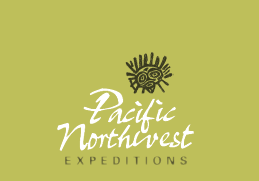Johnstone Strait - Blackfish Sound - Broughton Archipelago Sea Kayaking, Humpback & Killer Whales
6-Day Kayak Expedition
Day One - Sunday
We will meet you at Telegraph Cove at 8:00 AM. Upon your arrival, we will assemble your gear and then assist you in the art of kayak stowage. Time will be spent familiarizing you with the kayaks as well as introducing some basic paddling skills. Before launching you will be provided with on-the-water safety instruction and demonstrations, and then once on the water we’ll make sure you are comfortable and secure.
We will set an easterly course into Johnstone Strait towards our private base camp, at Spyhop Point. 50 degrees 32.6'N 126 degrees 42.9'W (map?) Your guides have a thorough understanding of the marine conditions to be expected during the course of your trip. This information will play an important part in determining the route each day, but also key to the plan is for you to have the greatest opportunity possible for an encounter with Orcinus orca, the Killer Whale.
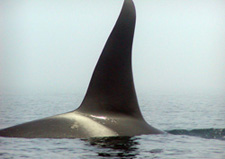 We are proud to be part of the friendly network of whale watchers and researchers in the Johnstone Strait area. Cooperation means that we share information which allows us all to help maintain viewing guidelines, which is intended to protect the whales 'space'. This, combined with our many years of experience, ensures that our success in seeing Killer Whales is extremely high. Please keep in mind however, these are wild animals and we can not 'predict' their behaviour. Everyday is different, and the very best outlook you can have is one of appreciation for whatever Nature provides. We are proud to be part of the friendly network of whale watchers and researchers in the Johnstone Strait area. Cooperation means that we share information which allows us all to help maintain viewing guidelines, which is intended to protect the whales 'space'. This, combined with our many years of experience, ensures that our success in seeing Killer Whales is extremely high. Please keep in mind however, these are wild animals and we can not 'predict' their behaviour. Everyday is different, and the very best outlook you can have is one of appreciation for whatever Nature provides.
Our ocean kayaks really are the perfect vehicle for intimate access to this diverse and fascinating marine world. You'll love the vantage point from a sea kayak for discovering intertidal zones alive with colourful invertebrates, right under your boat. Sleek and quiet, we can explore the many beaches and the unique surrounding ecosystem of the coastal temperate rain forest, which rises up majestically on both sides of Johnstone Strait.
By the time we stop for lunch you should feel quite satisfied in your ability to propel yourself forward and have gained an appreciation for the stability and comfort of your kayak. If the tide and wind are in our favour we just might make it all the way to camp, if not, after lunch we’ll continue east along Johnstone Strait and arrive at Spyhop later in the day, your home for the next two nights. Pacific Northwest Expeditions has developed and maintains this site which is strategically located in the core travel area of the resident Orca pods. The Robson Bight (Michael Bigg) Ecological Reserve is further east of our camp and is a favoured destination of the Orca.
After camp is set-up, we might return to the water for an afternoon paddle, or amuse yourself in camp, drawing, taking pictures or relaxing with a book you have been yearning to start. We have a collection of natural and cultural history reference books for your use.
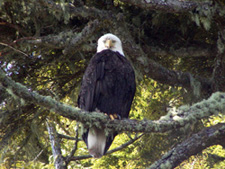 Later, while your dinner is being prepared, keep a watchful eye towards the shoreline. The view from our beach is superb, one of the best in the Strait and binoculars are highly recommended. The ocean floor adjacent to the beach is steep, which allows the Resident Orca to patrol the kelp beds close to the shore in search of their favourite meal, Chinook salmon. This close proximity often provides some of the best opportunities for photographing the whales. Don’t be surprised by the sight of the cook running from the galley with camera in hand! Later, while your dinner is being prepared, keep a watchful eye towards the shoreline. The view from our beach is superb, one of the best in the Strait and binoculars are highly recommended. The ocean floor adjacent to the beach is steep, which allows the Resident Orca to patrol the kelp beds close to the shore in search of their favourite meal, Chinook salmon. This close proximity often provides some of the best opportunities for photographing the whales. Don’t be surprised by the sight of the cook running from the galley with camera in hand!
We have often watched a family of river otters fishing for sculpins in the same kelp beds that the Orca regularly patrol seeking out salmon. Once a bald eagle swooped in trying to steal a dinner from the otters!. Sea Lions may suddenly and noisily break the surface...then disappear.
Johnstone Strait is also a working passage, and at times there can be fishing boats pulling in their nets, tugboats towing, cruise ships cruising and of course, other kayakers kayaking. But all the activity only adds to the excitement and 'watchability' of the area. There is nowhere else like it, it can't be explained, it has to be experienced.
Day Two - Monday
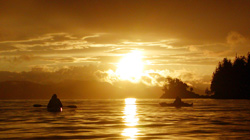 Awake in the morning to the aroma of brewing organic coffee, and come on down to enjoy a breakfast in Pacific Northwest Expeditions ‘Blackfish Galley’. If you're an early riser, sunrises in Johnstone Strait are as brilliant as the sunsets. Awake in the morning to the aroma of brewing organic coffee, and come on down to enjoy a breakfast in Pacific Northwest Expeditions ‘Blackfish Galley’. If you're an early riser, sunrises in Johnstone Strait are as brilliant as the sunsets.
You may be interested to participate in the daily gathering of logistical information that we use to prepare us for the days paddle. Analyze the marine weather forecast, consult the area marine chart, or calculate the daily tides and currents. Navigation, tying knots and building fires are all part of what makes sea kayaking so interesting and you can be involved in as much, or as little as you wish.
The beaches to the west of the Michael Bigg Ecological Reserve, commonly known as Robson Bight, will most likely be the day's destination. Robson Bight is famous for the ‘round pebble’ beaches on which the whales were first observed rubbing their bodies, a phenomenon known only to this unique population of Orca whales. Dr. Michael Bigg pioneered Orca identification which has resulted in a greater understanding and appreciation of these powerful creatures. Robson Bight is protected as an Orca sanctuary and we do not actually enter the reserve.
After a couple of hours of paddling it's usually time for a snack and stretch on a suitable beach. We'll pack a picnic lunch to satisfy the kind of appetite that fresh air and exercise demands.
Although Johnstone Strait is one of the best places in the world to see Orca, it is not limited to these marine mammals. Often Dall's Porpoise, the world’s fastest small cetacean, jet-propel by chasing small fish or each other. At various times the Pacific White Sided Dolphins, Humpback Whales or Minke Whales make appearances in Johnstone Strait.
At the day's end we return to our camp for a fireside dinner, which includes (we hope) some freshly caught salmon. Hopefully a big one. Hopefully a sockeye. (fishing = hoping) After the fire has burned down to coals and you're warmly snuggled in your tent, listen for the blows of the passing Orca.
Day Three - Tuesday
Today we break camp and paddle across Johnstone Strait, into Blackfish Sound (Blackfish, is a name commonly used for Orca on the coast of British Columbia) and the southern Broughton Archipelago. Our departure time is dependent upon the tide and currents, which need to be in our favour to paddle through Blackney Passage.
We will establish our new home at our private camp at Compton Island. 35 degrees .8' N 126 degrees 41.3'W (north beach). This is the land of the Mamalilikulla-Qwe'Qwa'Sot'Enox people, whose Chief and Council and been gracious enough to allow us the privilege of camping on this sacred island. Care must be taken to avoid disturbing ancient middens as some of the lovely white shell beaches have been used for centuries as summer camps by the First Nations. A wonderful island to explore with trails leading to all corners. Compton Island is also the site of the largest Amanita muscaria, or Fly Agaric, (mushrooms) we have ever seen, and many other spectacular fungi which are helping the forest recycle its nutrients.
Later in the afternoon, we'll explore the Blackfish Sound, Broughton Archipelago area with its many paddling routes. During the summer months the area is of particular interest to birders as there is a dense population of nesting Bald Eagles, and it is also a migratory route for many species of water fowl. As we tour through Blackfish Sound you will likely see a great number of Phalaropes and Rhinoceros Auklets gathered to feed in the nutrient rich waters. We often see Ancient and Marbled Murrelets bobbing high in the waves.
Though prime Orca viewing territory, its here, in Blackfish Sound, that you also stand a very good chance of seeing one or more of the summer resident Humpback Whales. These baleen whales were hunted almost to extinction during the whaling days, but a worldwide ban in 1966 has allowed the population some recovery. Since the beginning of this century (2000) we have been very fortunate to have Humpback whales once again make regular appearances to the Inside waters.
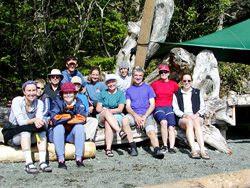 Weather and sea conditions will form the basis for all travel plans of the day. Evenings are often spent together conversing, playing games, or telling stories. One of the greatest pleasures of the multi day trips has to be the camaraderie and fun that every group develops. But, similar to learning navigation skills, participation is always optional and time alone may be just what you need. Weather and sea conditions will form the basis for all travel plans of the day. Evenings are often spent together conversing, playing games, or telling stories. One of the greatest pleasures of the multi day trips has to be the camaraderie and fun that every group develops. But, similar to learning navigation skills, participation is always optional and time alone may be just what you need.
When conditions are right and safety is assured, we'll head out for a night paddle. Paddling in 'bioluminescence' under a very starry sky is quite an amazing experience. (Bioluminescence is the emission of light produced by organisms which convert chemical to radiant energy-lots of sparkles).
Day Four - Wednesday
After our breakfast, we will be off to further explore the Broughton Archipelago. This maze of Islands is the territorial lands of the Kwakwa’ka’wakwl First Nations people and evidence of their ancient culture is still evident today. An abundance of natural resources once allowed a very rich cultural life full of complex customs, sophisticated art and dance. Fragmented and undermined by modern 'civilization' today's people are struggling to regain their heritage and move forward. We recommend a visit to the U'Mista Cultural Center in Alert Bay if you wish to gain a greater understanding of First Nations history and to see examples of the art that symbolize this part of the world so beautifully.
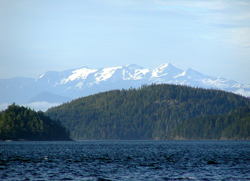 By now, even the least experienced paddlers will be moving through the water like pros. You'll be amazed to find how quickly you become proficient at sea kayaking. The basic design of the sea kayak hasn't changed in thousands of years because its form and function works very well. Efficient and balanced, a good forward stroke is far less tiring than you might expect. By now, even the least experienced paddlers will be moving through the water like pros. You'll be amazed to find how quickly you become proficient at sea kayaking. The basic design of the sea kayak hasn't changed in thousands of years because its form and function works very well. Efficient and balanced, a good forward stroke is far less tiring than you might expect.
This day will be filled with paddling through waters alive with marine life, searching hidden lagoons, and exploring the rugged coastline aged by winter storms. (though once the whole group mutinied and we spent the day swimming and dozing in the sun).
We will lunch on one of the many secluded islets, we have a couple of favourites where the views are particularly wonderful. Microclimates abound and even within a fairly small area, ecosystems can be very different. There are unique examples of pillow lava and other interesting rock formations. As time and interest allows, we'll troll for salmon or hike through the coastal rainforests. A late afternoon paddle returns us to our camp on Compton Island and dinner. The dark starry night sky, far away from city lights, is definitely worth staying up for.
Day Five - Thursday
We return to Johnstone Strait today and our route takes us back into the realm of the Orca. At times, it seems the whales are as curious about us as we are about them. (At no time do we harass or chase them) Most times they ignore us, though with their multi dimensional view of their world, you can be sure they know exactly where we are. They go about their business of being whales while we sit together quietly on the water and simply enjoy the thrill of being in their presence.
We may submerge our hydrophone and listen in. It is impossible to describe the thrill of seeing, and hearing these magnificent creatures in the wild. The Northern Resident Orca as well as many of the Transient Killer Whales have all been photographed and named so it can be a fun challenge to identify the individuals. We keep a daily log and submit our findings to the Cetacean Sightings Network.
Ask your guides about the Wild Killer Whale Adoption Program. You may go home with a family that is a LOT bigger. At the days end, we set up camp for our final evening in the Strait.
Day Six - Friday
We'll break camp in the morning and set our course for Telegraph Cove, as a group of experienced paddlers, and friends. Although it is impossible to predict or guarantee any of the above, and the weather can create variables, we have described typical events based on our many years of paddling in Johnstone Strait.
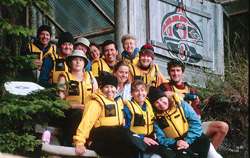 You will find that we are well organized and prepared for all circumstances and strive to make the most of each day. Typically we schedule our return to Telegraph Cove between 12:00 PM and 2:00 PM to allow you sufficient time to return down Island to catch ferries to the Mainland, or flights out of Port Hardy. You will find that we are well organized and prepared for all circumstances and strive to make the most of each day. Typically we schedule our return to Telegraph Cove between 12:00 PM and 2:00 PM to allow you sufficient time to return down Island to catch ferries to the Mainland, or flights out of Port Hardy.
We hope that upon our return to the Cove, you will join us for a final lunch at the Killer Whale Cafe, and a visit to the local Whale Interpretive Centre and Bones Project. It is usually between 4:00 PM and 5:00 PM before we say, "Thank you so much for choosing to spend your vacation with us...until the next time!"
Itineraries
Itineraries are intended to describe the experience you can expect from your sea kayaking adventure with us. Pacific Northwest Expeditions reserves the right to change the itinerary without advance notice at the discretion of the guides, due to weather conditions, tides and currents, activities en route or other logistical situations at the time of the trip. Pacific Northwest Expeditions is committed to consistently operate trips of high quality and safety without compromise.
Custom Trips
Customizing this trip to accommodate a group of friends, family members or colleagues can be arranged for 8 to 12 people. We are happy to discuss your ideas or make suggestions.

|
